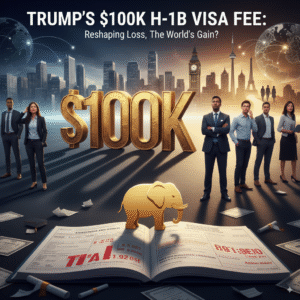The tech industry together with international students and major corporations in the United States face major disruption because Donald Trump’s administration announced a policy requiring $100,000 annual fees for H-1B visas. The Trump administration presents this policy as a worker protection measure but its actual effects extend far past its stated purpose.
With the United States serving its position as the preferred destination for worldwide talent and innovation yet the new policy imposes substantial financial costs on immigrant workers and their employers which could transform global labor markets and corporate operations and discourage skilled professionals from working in America.
This guide provides a detailed examination of the $100,000 annual H-1B visa fee structure, its effects on U.S. economic performance, technology, healthcare sectors, international students, corporate operations and worldwide migration trends. The analysis will evaluate this proposal through comparison with immigration systems operating in Canada, the UK, Europe which stand to gain from this policy change.
Understanding the $100,000 Fee Per Year for H-1B Visas
The H-1B visa program started as a system which enables U.S. businesses to employ foreign experts who work in specialized fields including engineering and information technology and finance and healthcare. The current process of H-1B visa sponsorship requires employers to cover $5,000 to $8,000 in fees which include filing expenses and legal costs and USCIS charges.
Trump requires H-1B visa holders to pay $100,000 annually for their visa status. And businesses spend six-figure annual costs for each foreign worker they decide to sponsor.
The new policy creates two major challenges for businesses because it establishes both financial obstacles and changes the direction of U.S. immigration policy toward domestic workforce protection over international talent recruitment.
Why Trump Introduced Trump’s $100K H-1B Visa Fee

Trump has been deeply critical of the H-1B visa program, which he says has made it easier for companies to hire cheaper foreign labour instead of recruiting Americans. The $100,000 annual fee on H-1B visas has a couple purposes:
- Deter hiring from abroad: If costs balloon, companies may be hesitant to hire from abroad.
- Promoting U.S. citizen employment: Employing foreign hires will become more expensive and hiring American workers will naturally become attractive.
- Generating federal revenue: The fees would create billions of dollars in annual government revenue.
- Political point: This dovetails with Trump’s broader “America First” immigration message he’s had since the beginning of his campaigns.
How the $100,000 Fee for H-1B Visas Affects Tech Companies
The H-1B visa program serves as the primary immigration channel for technology companies because they depend on international talent acquisition. The H-1B visa program enables Google, Microsoft, Amazon, Meta and Apple to bring in thousands of skilled foreign workers annually because the United States lacks sufficient domestic talent to fill specific positions mainly in STEM fields.
With the implementation of Trump’s $100K H-1B visa fee will lead to these consequences for companies:
- Escalating labor costs: The annual expenses for each foreign worker hired will reach $100,000 which may exceed the budget capabilities of startups and midsized businesses.
- Reduced hiring flexibility: The H-1B visa sponsorship process will become less accessible to smaller businesses because they lack the financial resources to compete with larger corporations.
- Offshoring trend acceleration: The high fees will push companies toward establishing operations in foreign markets which offer lower talent costs.
- Impact on innovation: The decrease in diverse talent will negatively affect technological development and research outcomes.
The proposal faces opposition because H-1B workers already make up 75% of the tech industry workforce according to existing reports which demonstrates its potential to disrupt Silicon Valley operations.
| Company Category | Approximate US Revenue Exposure | Reliance on H-1B Visa Workers | Potential Impact of $100K Visa Fee |
| Top-tier Indian IT firms | ~55% | High | Margins could shrink by up to 150 bps |
| Mid-cap Indian IT firms | 75% to 80% | Very High | Potential need to offshore work |
| US Big Tech Companies | Significant | Moderate to High | Advised employees to stay or return |
Impact on Indian Professionals
Indians are the largest beneficiaries of the H-1B program. The annual $100,000 fee for H-1B visas would create a barrier that prevents most employers from hiring Indian workers.
The proposed fee structure would create an insurmountable obstacle for Indian professionals who work in information technology and engineering and data science and healthcare.
- Fewer job opportunities in the U.S.: financial burden of H-1B sponsorship will force employers to select fewer Indian candidates for employment
- Shift towards Canada and Europe: United States will lose its position as a preferred destination for immigrants because other nations with welcoming immigration policies will attract more people.
- Barriers for students transitioning to work: H-1B pathway which allows Indian students to work in the United States after finishing their education will experience substantial reduction.
- Increased competition at home: limited number of available migration options will force skilled workers to stay in India thus intensifying domestic job competition.

Global Shift: Canada, UK, and Europe as Beneficiaries
The United States faces a risk of losing global talent to other countries when it implements expensive immigration policies. The UK, Canada, European Union member states have established welcoming immigration policies to capture international talent because they understand economic expansion requires foreign workforce attraction.
- Canada: Tech Talent Strategy which provides permanent residency pathways to international workers thus becoming a desirable choice.
- UK: The new points-based system which focuses on skills over nationality to create better migration opportunities for STEM professionals.
- Europe: Germany has introduced simplified residence permits for technology sector employees.
The implementation of Trump’s $100K H-1B visa fee would allow foreign nations to surpass America in technological leadership because they welcome international talent.
Do you know about UAE’s Golden Visa? Read the complete blog to get perfect idea about it.
Economic Implications of Trump’s $100,000 H-1B Fee
The United States economy has always benefited from immigration of skilled workers. Research indicates that:
- The H-1B visa program enables 50% of Silicon Valley startups worth more than $1 billion to be founded by its recipients.
- Immigrants represent more than 25% of all patent applications submitted to the United States.
- The U.S. Chamber of Commerce reports that foreign workers solved essential positions which American workers lacked the qualifications to perform.
Introducing high annual fee would lead to three major negative effects:
- The introduction of such a high annual fee would lead to decreased innovation and startup success and reduced entrepreneurship.
- The economy will experience reduced GDP expansion because foreign competition will become less competitive.
- The company will send operations abroad because they need to redirect their funds to other countries.
Political Backdrop of Trump’s $100K H-1B Visa Fee
The economic approach to immigration policy serves as more than financial regulation because it contains strong political elements. The core of Trump’s immigration story has focused on protecting American jobs while decreasing foreign workforce dependence. Trump uses the label of protecting American jobs to win support from particular voting groups.
It could lead to negative effects on both corporate America and diplomatic relations with India in the long run.
Reaction from Corporations and lobbyists
The fee has received opposition from tech companies, universities and industry leaders who have expressed their concerns about its implementation.
- Hurt U.S. innovation.
- The nation loses domestic employment positions through this policy.
- The policy discourages foreign students from studying in American educational institutions.
- Competitor nations will have the opportunity to match American advancements in AI and quantum computing and biotechnology.
Compete America and the Information Technology Industry Council function as lobbying groups which maintain that the proposal threatens to damage America’s economic development.
What This Means for International Students
The F-1 visa system allows Indian and Chinese students to enter the United States before they transition to H-1B visas for extended employment. The new $100,000 yearly H-1B visa fee will create a major disruption in the career development process.
- The new policy will reduce available job openings for recent graduates.
- Students should consider alternative immigration options including O-1 visas, EB-2 NIW, Canadian and UK residency programs.
- The new work restrictions may lead to reduced enrollment at U.S. universities because students will select countries with more accessible employment opportunities.
Struggling to find motivation to study? Read this blog for tips for concentration
Alternatives: What Skilled Workers Can Do
The $100K H-1B visa fee set by Trump does not stop professionals and students from using these alternative international migration routes:
- Canada Express Entry and PGWP (Post-Graduate Work Permit).
- UK Skilled Worker Visa provides skilled workers with affordable employer fees for visa applications.
- Australian and German immigration systems provide quick residency access to qualified foreign workers.
- Digital nomad visas across European and Latin American countries enable remote workers to migrate.
Predictions for the Future
If Trump’s $100,000 H-1B yearly fee get implemented, it would lead to:
- Number of foreign worker sponsorships would decrease right away.
- Businesses would accelerate their practice of sending work to other countries while they hire remote workers from different locations.
- Higher education institutions would experience significant drops in student enrollment numbers.
- United States would lose its position as the world’s innovation center because other countries would attract more talent in AI and software engineering fields.
The situation holds enormous importance because it affects both migrant workers and the United States’ position as the global center of innovation.
Global Perspective on the $100,000 H-1B Visa Fee
From a global standpoint, the annual $100,000 H-1B visa fee would create substantial changes in how skilled workers choose to migrate between countries worldwide. The United States will lose its appeal to skilled workers because of its new visa policy which will drive these professionals to seek employment in Canada and the UK and Germany and Australia. These countries promote themselves as worldwide innovation centers through their affordable visa systems and efficient residency processes and enduring career prospects.
The implementation of Trump’s $100K H-1B visa fee would drive international students and professionals toward alternative locations which would speed up the worldwide shift of high-skilled talent and boost technology development in non-US markets.

Global Perspective on the $100,000 H-1B Visa Fee: Supporting Statistics
The annual $100,000 H-1B visa fee will create major obstacles for worldwide talent movement because India leads the way as the main source of H-1B visa recipients. The H-1B visa program receives 70-73% of its annual recipients from India while China follows with 11-12% of the total. The fiscal year 2024 H-1B visa lottery system distributed 85,000 new visas each year with technology positions making up more than 65% of the total and STEM field visa holders earning median salaries of $123,600.
The proposed $100,000 annual fee exceeds the present H-1B sponsorship costs between $5,000 and $8,000 which would make foreign worker hiring unaffordable for numerous businesses including Indian IT companies that rely on U.S. tech markets. The H-1B visa program supports thousands of workers at Infosys and TCS while these employees generate between 2-3.3% of total workforce numbers and their revenue contributions reach 7-11% for specific companies. The new fee structure has the potential to eliminate all financial benefits obtained from these workers.
Meanwhile, Canada stands as a leading choice for skilled migrants who want to immigrate. Welcoming more than 207,000 new residents during the first half of 2025 through skilled worker programs while it aims to welcome 415,000 permanent residents by the end of the year to keep its position as a top destination for skilled workers. The UK and European countries have introduced new skilled worker visa programs which provide lower costs than the proposed U.S. immigration fees. (source: bbc)
Conclusion
The proposed $100,000 annual fee for H-1B visas represents a major change in U.S. immigration policy which could discourage international talent from entering the country while creating problems for the technology industry and pushing skilled workers toward Canada and European nations. The $100K H-1B visa fee proposed by Trump aims to protect American workers but it could lead to negative effects on innovation, economic growth and damage the United States’ status as the global talent and entrepreneurial center.
FAQs on $100,000 Fee per Year for H-1B Visas
Q1: What is Trump’s plan to charge H1Bs $100,000 per year?
It’s a policy proposal that would require employers to pay $100,000 for each H-1B worker sponsored — far in excess of current visa costs.
Q2: Who Is to Be Hit Hardest by Trump’s $100K H-1B Visa Fee?
Tech firms, Indian IT workers, international students in the US, and startups will be worst-hit.
Q3: So how can Trump justify this $100,000 H-1B fee?
The rationale is that we need to protect American workers, prohibit the hiring of cheap foreign labor and increase government revenues.
Q4: What are the other options for skilled professionals in case H-1B becomes unaffordable?
Canada, UK, Australia and the EU possess economic, immigrant-friendly competitive talent migration options.


